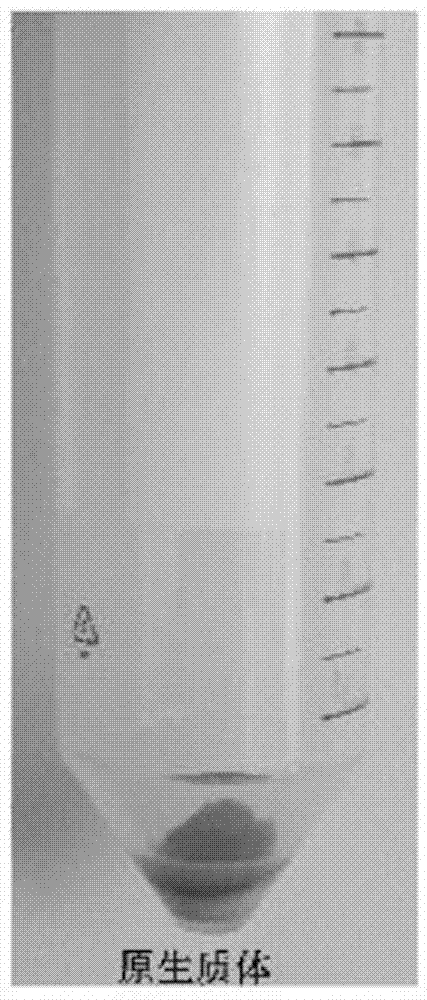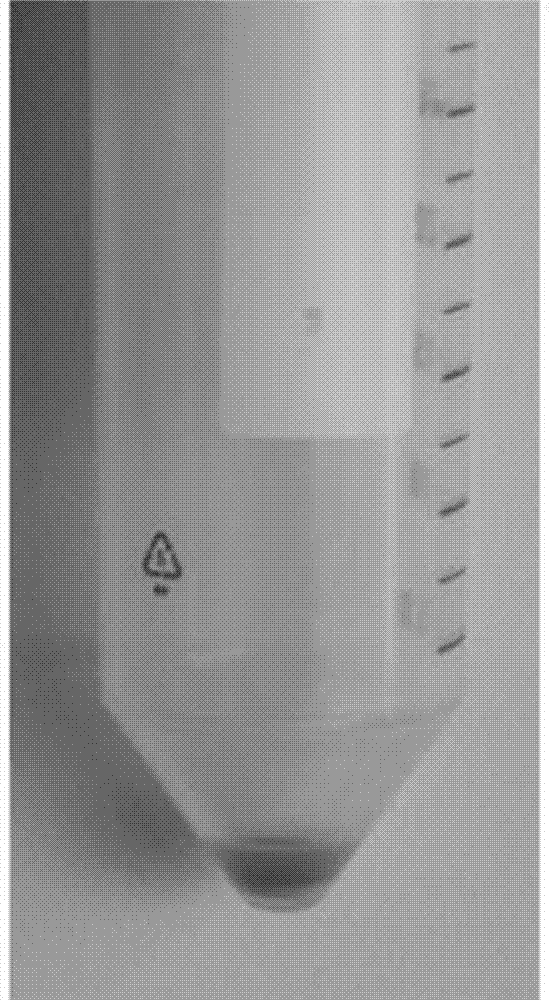High-purity and high-quality extraction method of chloroplast DNA of strip-leaf plants
An extraction method and plant leaf technology, which is applied in the field of extracting high-purity chloroplast DNA from a large number of small strip-shaped leaf plants, can solve the problem of inability to extract high-purity chloroplast DNA, high-quality, high-concentration chloroplast DNA, and mesophyll The problem of low cells
- Summary
- Abstract
- Description
- Claims
- Application Information
AI Technical Summary
Problems solved by technology
Method used
Image
Examples
Embodiment 1
[0088] Embodiment 1, the extraction of millet chloroplast DNA.
[0089] 1. Isolation of protoplasts from millet leaves.
[0090] (1) Sow the seeds of the millet material on the seedling tray, and cut 30-40 g of fresh and healthy leaves before heading; cut the leaves into tiny thin strips horizontally and vertically with a medical scalpel, causing more traumatic surfaces, To facilitate the infiltration of the enzymatic solution.
[0091] (2) Put the treated leaves in 100 mL of enzymatic hydrolysis solution, submerge the leaves in the enzymatic hydrolysis solution, and shake for 3 h with a decolorizing shaker at 30 rpm in the dark.
[0092] (3) Dilute the enzymolyzate with 100 mL of buffer 1, filter through a 200-mesh cell sieve, collect the filtrate, and discard the residue; filtrate 4 o C, 200 g, centrifuge for 10 min, collect the precipitate, which is the protoplast ( Picture 1-1 ).
[0093] 2. Removal of millet mitochondria and rough extraction of chloroplasts.
[0094...
Embodiment 2
[0107] Embodiment 2, extraction of wheat chloroplast DNA.
[0108] 1. Isolation of protoplasts from wheat leaves.
[0109] (1) Sow the seeds of wheat materials in a petri dish, cultivate them in clear water, and cut 20-30 g of fresh and healthy leaves; cut the leaves into tiny thin strips horizontally and vertically with a medical scalpel, causing more traumatic surfaces, To facilitate the infiltration of the enzymatic solution.
[0110] (2) Place the treated leaves in 100 mL of enzymatic hydrolysis solution, submerge the leaves in the enzymatic hydrolysis solution, and shake for 3 h with a decolorizing shaker at room temperature, 30 rpm, in the dark.
[0111] (3) Dilute the enzymolyzate with 100 mL of buffer 1, filter through a 200-mesh cell sieve, collect the filtrate, and discard the residue; filtrate 4 o C, 200 g, centrifuge for 10 min, collect the precipitate, which is the protoplast ( diagram 2-1 ).
[0112] 2. Removal of wheat mitochondria and rough extraction of c...
PUM
 Login to View More
Login to View More Abstract
Description
Claims
Application Information
 Login to View More
Login to View More - R&D
- Intellectual Property
- Life Sciences
- Materials
- Tech Scout
- Unparalleled Data Quality
- Higher Quality Content
- 60% Fewer Hallucinations
Browse by: Latest US Patents, China's latest patents, Technical Efficacy Thesaurus, Application Domain, Technology Topic, Popular Technical Reports.
© 2025 PatSnap. All rights reserved.Legal|Privacy policy|Modern Slavery Act Transparency Statement|Sitemap|About US| Contact US: help@patsnap.com



